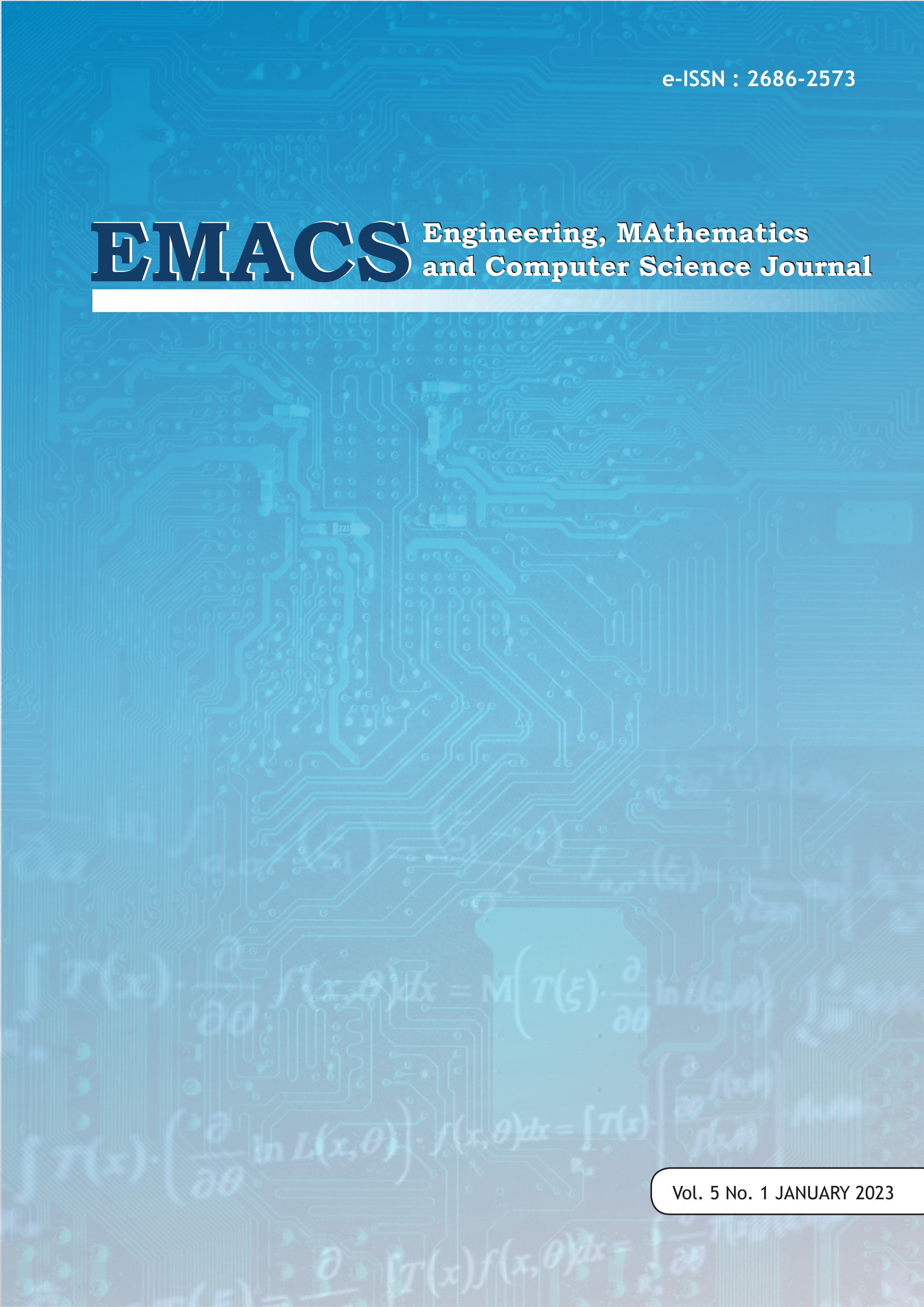IoT Based Vehicle Safety Controller Using Arduino
DOI:
https://doi.org/10.21512/emacsjournal.v5i1.9251Keywords:
IoT, RFID, GPS, Arduino, AndroidAbstract
Several people try to break into vehicles and steal vehicles left by their owners, sometimes even without the owner's knowledge. There are still various ways that can be done to a turn on the vehicle without the key from the vehicle so that the vehicle can be stolen easily. Due to the ease of break-in from some vehicles, several additional security implementations can be installed. One of these ways is to implement IoT and RFID. There are several implementations of IoT as an extra device for safety and tracking vehicles. RFID can be Implemented as an additional key or access. IoT and RFID can be combined to provide additional safety for vehicles and prevent vehicle theft. This research aims to propose a device that uses IoT technology and RFID to keep the vehicle safe and track the use of the vehicle. This research use Arduino, RFID, and GPS module. The proposed device was tested under various conditions of RFID use and the level of accuracy of the GPS module used. The test results show that the proposed tool can work well for security and tracking needs.
References
Andriansyah, M., Subali, M., Purwanto, I., Irianto, S. A., & Pramono, R. A. (2017). E-KTP as the basis of home security system using arduino UNO. 2017 4th International Conference on Computer Applications and Information Processing Technology (CAIPT), 1–5.
Costa, F., Genovesi, S., Borgese, M., Michel, A., Dicandia, F. A., & Manara, G. (2021). A review of RFID sensors, the new frontier of internet of things. Sensors, 21(9), 3138.
Datta, N., Malik, A., Agarwal, M., & Jhunjhunwala, A. (2019). Real time tracking and alert system for laptop through implementation of GPS, GSM, motion sensor and cloud services for antitheft purposes. 2019 4th International Conference on Internet of Things: Smart Innovation and Usages (IoT-SIU), 1–6.
Desima, M. A., Ramli, P., Ramdani, D. F., & Rahman, S. (2017). Alarm system to detect the location of IOT-based public vehicle accidents. 2017 International Conference on Computing, Engineering, and Design (ICCED), 1–5.
Harish, V., Chrisvin, D. S., & Thottungal, R. (2021). Overview of RFID Security and its Applications. 2021 International Conference on Advancements in Electrical, Electronics, Communication, Computing and Automation (ICAECA), 1–5.
Husni, M., Ginardi, R. V. H., Gozali, K., Rahman, R., Indrawanti, A. S., & Senoaji, M. I. (2021). Mobile Security Vehicle’s based on Internet of Things. Journal of Robotics and Control (JRC), 2(6), 546–551.
Ikuesan, R. A., Ganiyu, S. O., Majigi, M. U., Opaluwa, Y. D., & Venter, H. S. (2020). Practical Approach to Urban Crime Prevention in Developing Nations. Proceedings of the 3rd International Conference on Networking, Information Systems & Security, 1–8.
Kaur, P., Das, A., Borah, M. P., & Dey, S. (2019). Smart vehicle system using arduino. ADBU Journal of Electrical and Electronics Engineering (AJEEE), 3(1), 20–25.
Kemala, A. P., Syahputra, M. E., Lucky, H., & Achmad, S. (2022). Pengembangan Smart Air Condition Control Menggunakan Platform Blynk Berbasis Mikrokontroler ESP8266 dan Sensor DHT11. Engineering, MAthematics and Computer Science (EMACS) Journal, 4(1), 19–23.
Lv, Z., Qiao, L., Kumar Singh, A., & Wang, Q. (2021). AI-empowered IoT security for smart cities. ACM Transactions on Internet Technology, 21(4), 1–21.
Maghanoy, J. A. W. (2017). Crime mapping report mobile application using GIS. 2017 IEEE 2nd International Conference on Signal and Image Processing (ICSIP), 247–251.
Mahmoud, R., Yousuf, T., Aloul, F., & Zualkernan, I. (2015). Internet of things (IoT) security: Current status, challenges and prospective measures. 2015 10th International Conference for Internet Technology and Secured Transactions (ICITST), 336–341.
Muslem, I. (2020). Prototype Kunci RFID (Radio Frequency Identification) dalam Meningkatkan Keamanan Kendaraan Bermotor. Jurnal TIKA, 5(3), 70–76.
Nambiar, A. N. (2009). RFID technology: A review of its applications. Proceedings of the World Congress on Engineering and Computer Science, 2, 20–22.
Raman, D. R., Devi, S. G., & Saravanan, D. (2020). Locality based violation vigilant system using mobile application. 2020 International Conference on System, Computation, Automation and Networking (ICSCAN), 1–6.
Widjaja, D., Octaviandra, M. F. D., Achmad, S., & Sutoyo, R. (2022). Important Security Factors for Implementing Internet of Things in Smart Home Systems. 2022 International Conference on Informatics Electrical and Electronics (ICIEE), 1–7.
Wijenayaka, L. C., & Wedasinghe, N. (2018). Emergency Alert System for Reporting Crime Issues to Nearest Police Station.
Downloads
Published
How to Cite
Issue
Section
License
Copyright (c) 2023 Engineering, MAthematics and Computer Science (EMACS) Journal

This work is licensed under a Creative Commons Attribution-ShareAlike 4.0 International License.
Authors who publish with this journal agree to the following terms:
- Authors retain copyright and grant the journal right of first publication with the work simultaneously licensed under a Creative Commons Attribution License - Share Alike that allows others to share the work with an acknowledgment of the work's authorship and initial publication in this journal.
- Authors are able to enter into separate, additional contractual arrangements for the non-exclusive distribution of the journal's published version of the work (e.g., post it to an institutional repository or publish it in a book), with an acknowledgment of its initial publication in this journal.
- Authors are permitted and encouraged to post their work online (e.g., in institutional repositories or on their website) prior to and during the submission process, as it can lead to productive exchanges, as well as earlier and greater citation of published work.
USER RIGHTS
All articles published Open Access will be immediately and permanently free for everyone to read and download. We are continuously working with our author communities to select the best choice of license options, currently being defined for this journal as follows: Creative Commons Attribution-Share Alike (CC BY-SA)





